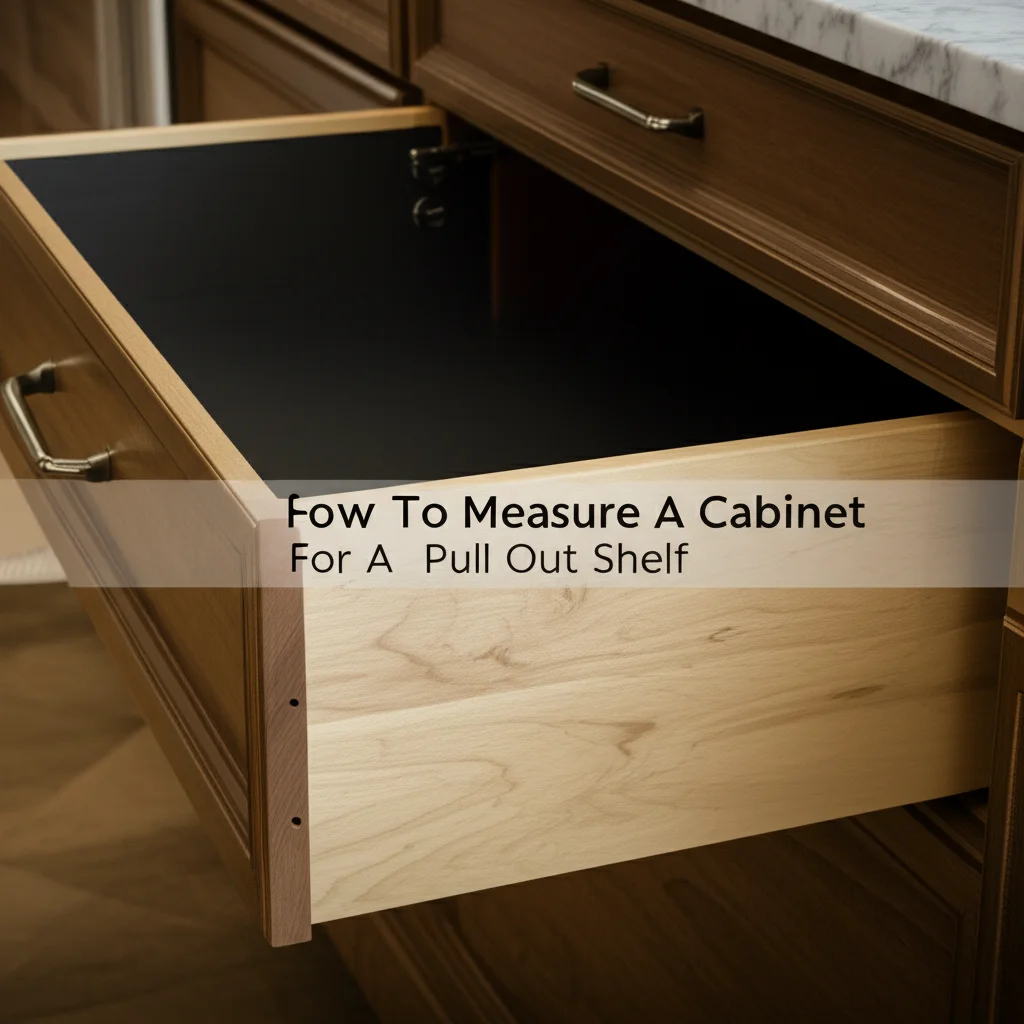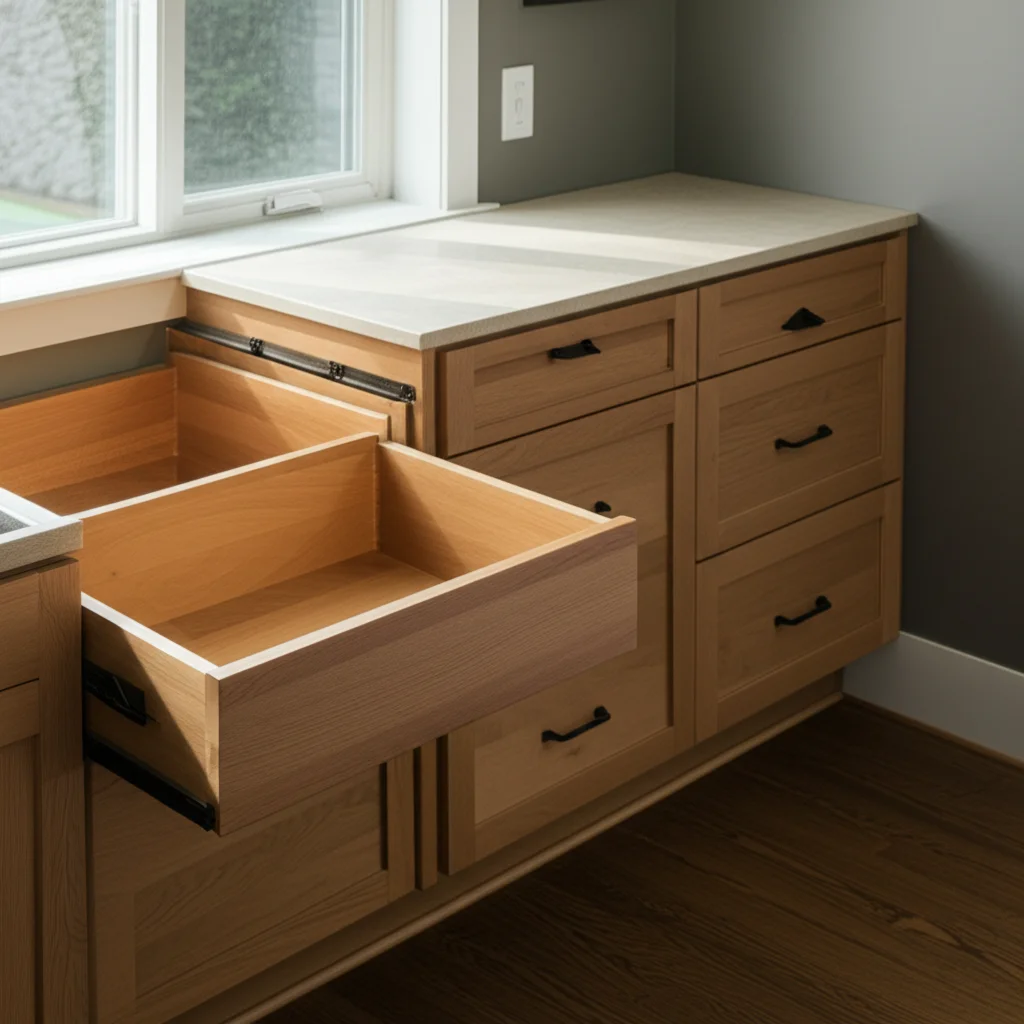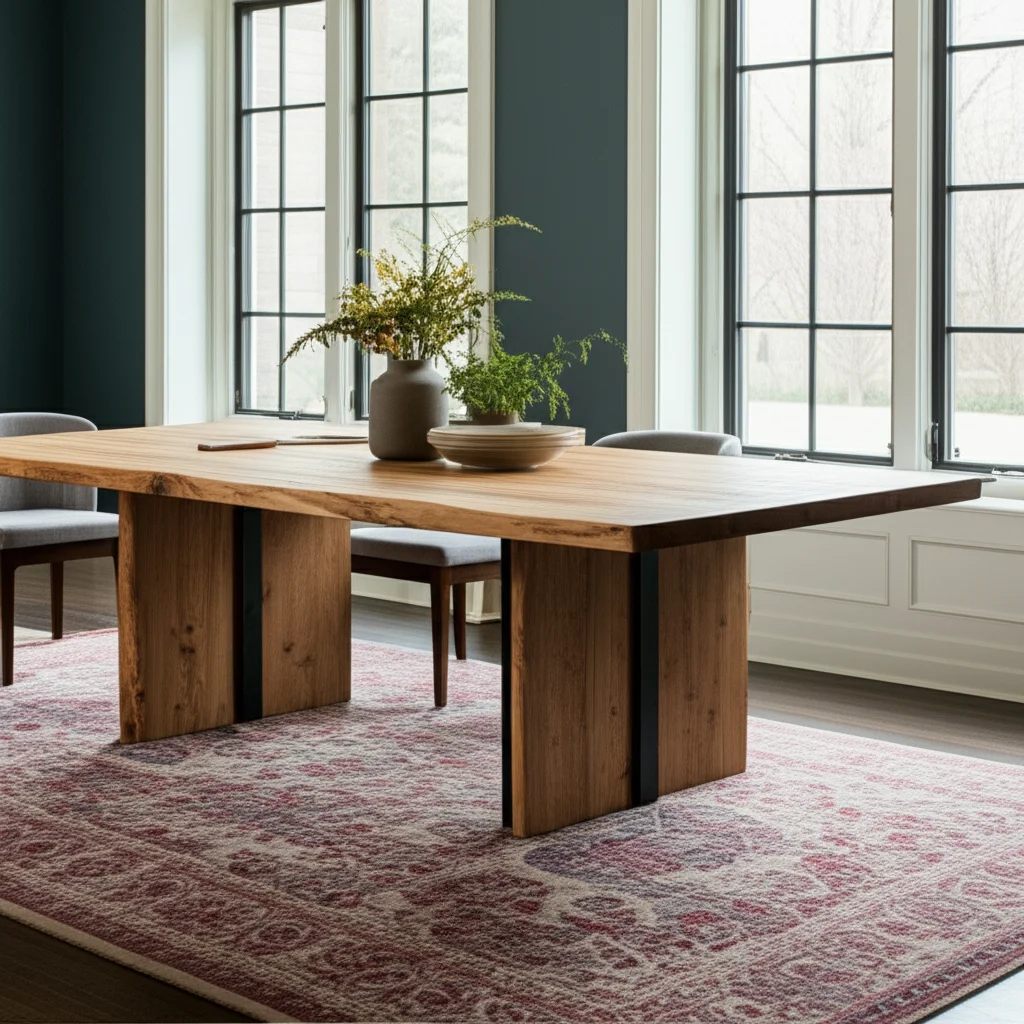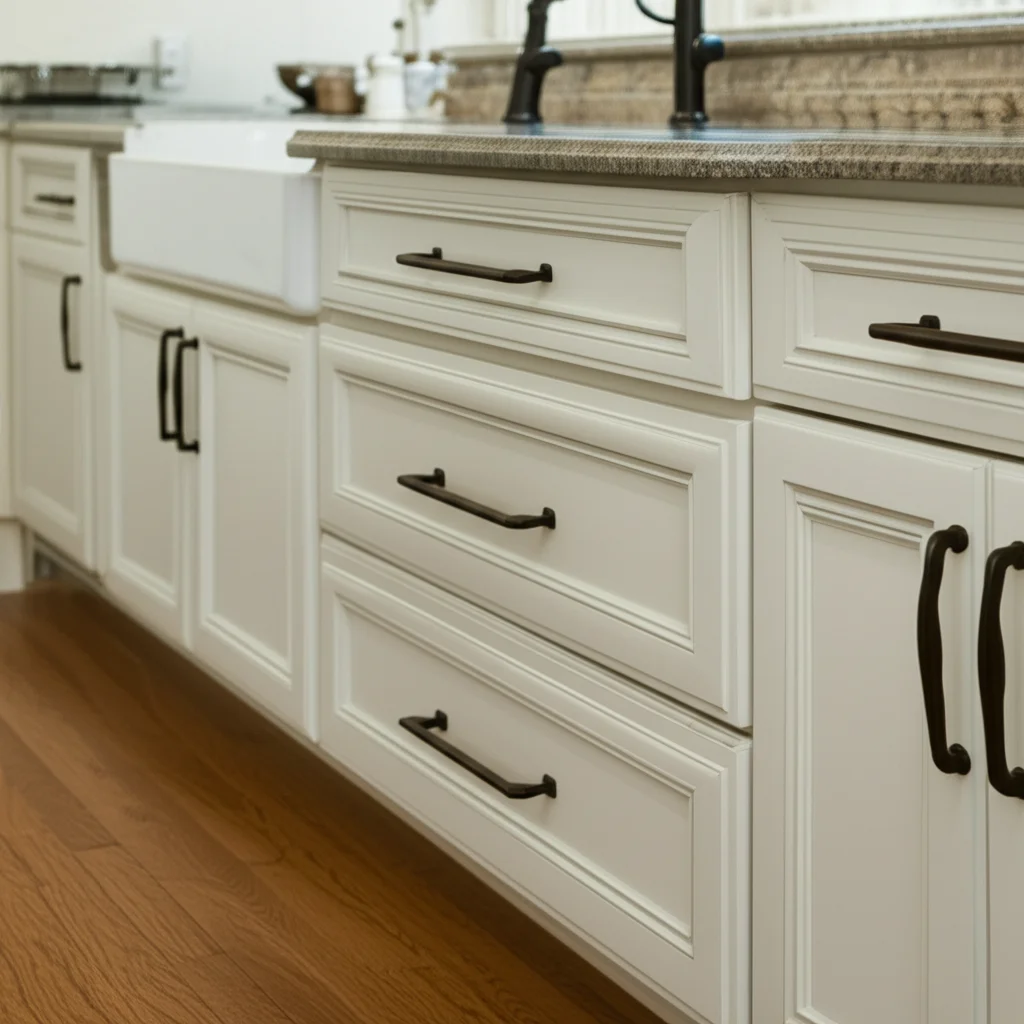· Katria Melrose · Home Improvement · 18 min read
How To Measure A Cabinet For A Pull Out Shelf

Transform Your Kitchen: How To Measure A Cabinet For A Pull Out Shelf
Imagine a kitchen where every item has its place, and finding ingredients is simple. This vision becomes real with pull out shelves. They bring contents from the back of your cabinets right to you. No more bending or reaching into dark corners. Learning how to measure a cabinet for a pull out shelf is the first step. This accuracy ensures a perfect fit.
An accurate measurement prevents problems later. It saves you time and money. It also guarantees your new shelves slide smoothly. I will guide you through each step. You will learn about the right tools, different cabinet types, and specific measurements. We will cover width, depth, and height. I will also share tips for avoiding common mistakes. By the end, you will feel ready to upgrade your cabinets. Get ready to transform your storage.
Takeaway
- Measure Inside Width: Find the narrowest point from side to side.
- Measure Inside Depth: Go from the back wall to the front opening.
- Measure Inside Height: Check the vertical space for the shelf and items.
- Account for Obstructions: Look for hinges, pipes, or door overlays.
- Double-Check: Always measure at least twice for accuracy.
To measure a cabinet for a pull out shelf, you must find the exact inside width, depth, and height of the opening. Carefully measure from wall to wall, front to back, and top to bottom. Remember to account for any internal obstructions like hinges or pipes. This precision ensures your pull out shelf fits perfectly and functions well.
Essential Tools for Accurate Cabinet Measurement
Starting any home improvement project needs the right equipment. Measuring a cabinet for a pull out shelf is no different. Having the correct tools makes the job easier. It also ensures your measurements are precise. Precision is key for a good fit.
You want to get this right the first time. Using the wrong tools can lead to errors. This means shelves that do not fit or function poorly. A few simple items are all you need. Gather these tools before you start.
Why the Right Tools Matter
Accurate measurements are the foundation of a successful project. A pull out shelf needs to fit snugly inside your cabinet. It should also slide without hitting anything. The right tools help you get exact numbers. They prevent guessing.
Think about it like this: a carpenter would not build a house without a tape measure. We need the same care for your cabinet. Precise tools reduce frustration. They save you from needing to return ill-fitting shelves.
Here is a list of essential tools:
- Metal Tape Measure: A stiff, metal tape measure is best. Fabric tapes can stretch. A metal tape gives you firm, unbending measurements. Choose one long enough to cover your cabinet’s full depth.
- Pencil and Notepad: You need to write down every measurement immediately. Do not rely on memory. A simple pencil and paper work great. Keep them handy as you measure.
- Level (Optional but Recommended): Sometimes cabinet floors are not perfectly level. A small level can help you check this. It ensures your base measurements are accurate.
- Flashlight: Cabinet interiors can be dark. A flashlight helps you see all corners and obstructions. It ensures you do not miss any details inside.
- Safety Glasses (Optional): While not directly for measuring, it is good practice to wear safety glasses when working in and around cabinets. This protects your eyes from dust or debris.
Using these tools will set you up for success. They make the measuring process simple. You will feel more confident in your results.
Understanding Cabinet Types: Face Frame vs. Frameless
Before you measure, know your cabinet type. This is very important for pull out shelves. Cabinets come in two main styles: face frame and frameless. Each type has specific measuring points. Understanding them prevents mistakes.
A wrong measurement here leads to a shelf that will not fit. Take a moment to look at your cabinet’s front. This quick check saves a lot of trouble. Identifying your cabinet style is simple.
Face Frame Cabinets and Their Measurement
Face frame cabinets are common in many homes. They have a solid wood frame on the front. This frame covers the opening. It looks like a picture frame around the cabinet door. The frame makes the opening smaller than the inside of the cabinet.
When measuring for a pull out shelf, you must measure the inside of this frame. Do not measure the full cabinet width. Measure from the inside edge of one vertical frame piece (stile) to the inside edge of the other. This opening is often narrower than the cabinet’s overall width. You will also need to account for any horizontal frame pieces (rails) if they are in the way.
Frameless Cabinets and Their Simpler Measurement
Frameless cabinets, also called Euro-style, have no front frame. The cabinet door covers the entire opening. The sides of the cabinet box are visible when the door is open. This design offers a larger opening. It also makes measuring easier.
For frameless cabinets, you simply measure the inside width from one side wall to the other. There is no frame to obstruct the opening. The full width of the cabinet interior is available. This often allows for wider pull out shelves.
Knowing your cabinet type guides your measuring strategy. It helps you focus on the right dimensions. This ensures your pull out shelf fits the available space.
Measuring Cabinet Width for Your Pull Out Shelf
Measuring the width is critical for any pull out shelf. It is often the first measurement people take. But it is easy to make a mistake if you do not measure carefully. The goal is to find the narrowest point. This ensures the shelf slides freely.
A pull out shelf needs enough side-to-side room. It also needs space for its slides. Get this measurement wrong, and your shelf will bind. It might not fit at all. So, pay close attention to details.
Inside Opening Width
Start by opening your cabinet door fully. For face frame cabinets, locate the vertical wood pieces. These are called stiles. Measure the distance between the inside edges of these two stiles. Measure at the top, middle, and bottom of the opening. Use the smallest measurement you find. This smallest number is your crucial width.
If you have frameless cabinets, the process is simpler. Measure the distance from the inside of one side wall to the inside of the other side wall. Again, take measurements at the top, middle, and bottom. Record the smallest width. This ensures your shelf clears any slight variations in the cabinet box.
Clearance Considerations
Pull out shelves mount on slides. These slides attach to the inside walls of your cabinet. They need space. Most drawer slides require about 1/2 inch of clearance on each side. This means the actual shelf width will be less than your measured opening width.
For example, if your inside opening width is 15 inches, your shelf unit might need to be 14 inches or less wide. Always check the specific product’s requirements for slide clearance. Some manufacturers build this into their shelf dimensions. Others require you to subtract it. Be sure to read the product specifications carefully.
You might also encounter other things inside the cabinet. Sometimes there are small bumps or screws. Measure around these. You want the shelf to clear everything. A little extra space is better than too little.
Determining Cabinet Depth for Optimal Pull Out Shelf Function
After measuring the width, depth is the next key dimension. The depth tells you how far the pull out shelf can extend into your cabinet. This measurement impacts how much storage space you gain. It also ensures the shelf clears the closed cabinet door.
Getting the depth right means your shelf will not stick out. It also means the door will close properly. A wrong depth measurement can leave your shelf too short or too long. Both scenarios are not ideal.
From Front to Back
To measure depth, open your cabinet door. Measure from the very back wall of the cabinet. Extend your tape measure straight forward. Stop at the point where the cabinet opening ends. For face frame cabinets, measure to the inside face of the front frame. For frameless cabinets, measure to the front edge of the cabinet box.
Just like with width, measure the depth at a few different points. Check the left, middle, and right. Use the smallest measurement you get. This accounts for any slight bowing or inconsistencies in the cabinet box. This small number ensures your shelf will fit the full length.
Obstructions and Projections
Cabinets often hide pipes, electrical outlets, or other things. These can reduce the usable depth. Look closely at the back and sides of your cabinet. If a pipe runs along the back wall, measure to the front of that pipe. This is your new effective back wall.
Door hinges are another common obstruction. They often project into the cabinet space when the door is closed. Measure from the back wall to the front of the hinge’s furthest point. This is crucial for the shelf to clear the hinge. Your pull out shelf system needs to clear these hinges. Sometimes, special spacers or brackets are needed. These help the slides clear hinges.
Also, think about the cabinet door itself. When the door closes, it takes up some space. You need to ensure the pull out shelf, when closed, sits far enough back. This allows the door to shut completely. Usually, leaving about 1 to 2 inches of space between the front of the shelf and the closed door is good. This prevents bumping. This also ensures your new shelves improve organization, not hinder it.
Measuring Cabinet Height for a Stacked Pull Out Shelf System
Measuring height is important, especially if you plan multiple pull out shelves. The height tells you how much vertical space you have. It guides how many shelves you can install. It also helps you determine the best spacing between them.
Proper height measurement ensures your items fit on the shelves. It also prevents shelves from rubbing against each other. This is key for a smooth operation. Do not overlook this vertical space.
Floor to Top
To measure the height, start from the bottom. Place your tape measure on the cabinet floor. Extend it straight up to the very top inside of the cabinet. This might be the underside of the next shelf, the cabinet top, or the underside of the cabinet frame.
If you have a fixed shelf already in place, measure from the cabinet floor to the underside of that shelf. Or, measure from the top of that fixed shelf to the cabinet top. This defines the usable height for a single pull out shelf. Again, measure in a few spots and use the smallest number.
Vertical Spacing for Multiple Shelves
Many people install more than one pull out shelf in a tall cabinet. If you plan a stacked system, vertical spacing matters a lot. First, decide what you will store on each shelf. Tall cereal boxes need more height than spice jars. This dictates the minimum distance between shelves.
Measure the height of your tallest item. Add at least 1-2 inches for clearance above it. This becomes your minimum vertical spacing. If you have 40 inches of total height, and your items are 10 inches tall, you could fit about three shelves. Each shelf would take up roughly 12 inches of vertical space (10 inches for the item + 2 inches for clearance).
Consider the height of the pull out shelf unit itself. Some units have taller sides or frames. Account for this in your height calculations. You also need space for the slides on the side. When planning multiple shelves, remember that each set of slides will take up some vertical room. Think about how easy it will be to reach items on the top shelf. Sometimes, fewer shelves with more space are better than many cramped ones. This careful planning ensures every pull out shelf adds maximum utility.
Accounting for Obstructions and Special Considerations
Measuring for a pull out shelf goes beyond simple dimensions. Cabinets often have hidden obstacles. These can impact how your shelf fits. Ignoring them leads to installation headaches. It is vital to look for these details.
Taking extra time here prevents rework. A good survey of the cabinet interior is important. This ensures a smooth installation of your pull out shelf. It ensures a perfect fit.
Hinges, Pipes, and Wiring
Hinges: Cabinet door hinges are a common issue. They often stick into the cabinet space when the door is closed. You must measure from the back wall to the furthest point of the hinge. This is your effective depth for the pull out shelf. Many pull-out shelf systems offer special spacers. These spacers mount behind the slide. They push the slide out a bit. This creates clearance for hinges. Make sure any chosen shelf system can work with your hinge type.
Pipes and Wiring: Kitchen cabinets, especially under sinks, might have pipes. Some also have electrical outlets or wiring. Measure around these. Your shelf system must clear them. If a pipe runs along the back wall, measure to the front of the pipe. If it is a drainpipe, ensure the shelf height allows for it. For plumbing, you might need a U-shaped pull out shelf. This design goes around the pipe.
It might be a good time to consider giving your cabinet a good cleaning before installing new shelves. Sometimes, years of use leave behind grime or debris that can get in the way. How to clean cabinet offers practical advice for tidying up your space, ensuring a clean slate for your new installation. If your existing cabinet hardware is worn or dirty, you might also consider an upgrade. Cleaning or replacing old hardware can make the whole cabinet look and feel new. You can find useful tips here: how to clean old cabinet hardware.
Cabinet Door Overlays
The way your cabinet doors sit also matters.
- Full Overlay Doors: These doors cover almost the entire cabinet face. They leave very little of the cabinet frame exposed. With these, the hinges are often mounted inside the cabinet. They might project inward when the door is closed.
- Partial Overlay Doors: These doors cover only part of the cabinet frame. A portion of the frame is visible around the door. Hinges might be exposed or hidden.
- Inset Doors: These doors sit flush with the cabinet frame. They are set into the opening. Hinges are often visible on the outside.
For all types, you must ensure the pull out shelf does not hit the door. When the shelf slides out, it needs to clear the door opening completely. If the door opens only 90 degrees, it limits how far the shelf can extend. You want the shelf to come out fully. This allows easy access to items. Think about the door swing and the path of the shelf. Sometimes, installing door stops helps. They prevent the door from hitting adjacent cabinets. This also protects your new pull out shelf.
These details matter greatly. They ensure your pull out shelf works as intended. Ignoring them causes frustration. A small adjustment during measuring saves a lot of time later.
Double-Checking Your Cabinet Measurements for a Flawless Fit
You have taken all your measurements. Now, the most important step: double-checking. This part might seem tedious. But it is crucial for a flawless fit. Trust me, it saves a lot of headaches later.
A small error in measurement can mean a pull out shelf that does not fit. It might be too wide, too deep, or too tall. Double-checking reduces this risk. It ensures your hard work pays off.
The Importance of Measuring At Least Twice
Always measure everything at least twice. I prefer three times for critical dimensions. Do not just repeat the measurement quickly. Step away for a moment. Then come back and measure again. Or, ask someone else to measure with you. A second pair of eyes often catches errors.
Use the exact same method each time. If you measured width at the top, middle, and bottom initially, do it again. Consistency helps confirm accuracy. If your measurements differ, find out why. Re-measure until you get consistent numbers. This ensures you have the correct data for your pull out shelf purchase.
Taking Photos of the Cabinet
Before you buy anything, take photos of your cabinet. Get wide shots showing the entire opening. Also, take close-up photos of any obstructions. These include hinges, pipes, or irregular areas.
When you are looking at pull out shelf products online or in a store, these photos are a big help. You can refer to them. They help visualize how the shelf will fit. They also remind you of any unique challenges. It is like having your cabinet with you.
Creating a Simple Diagram
A quick sketch of your cabinet can be very useful. It does not need to be an art piece. Just draw a simple box. Label the front, back, and sides. Write down your measured width, depth, and height on the diagram. Mark where hinges or pipes are. Note their distances from the cabinet sides or back.
This diagram helps you organize your measurements. It also serves as a visual check. You can easily see if a dimension looks off. It is a handy reference when you are comparing shelf products. This clear visual representation helps avoid errors.
When to Seek Professional Help
Most cabinet measuring is simple enough for DIY. But sometimes, a cabinet is unusual. It might have very complex obstructions. Or it could be an old, non-standard size. If you feel unsure after multiple checks, consider getting help.
Many pull out shelf retailers offer measuring services. Or you could consult a local handyman or cabinet professional. They have experience with tricky situations. Investing in a professional measurement can guarantee a perfect fit. It is better to pay a small fee than to buy an expensive shelf that does not fit. You want your new pull out shelf to be an asset.
Taking these extra steps makes a huge difference. They build confidence in your measurements. They also lead to a successful, stress-free installation of your new pull out shelf. You will enjoy organized cabinets for years to come.
FAQ Section
Q1: What is the most critical measurement for a pull out shelf?
The most critical measurement for a pull out shelf is the inside opening width. If the shelf is too wide, it will not fit through the cabinet opening. It will also not slide properly. Always measure this dimension at the narrowest point, especially in face frame cabinets. This ensures the shelf unit clears the frame or side walls when it moves.
Q2: Should I account for hinges when measuring depth?
Yes, absolutely. You must account for hinges when measuring cabinet depth. Hinges often project into the cabinet space when the door is closed. Measure from the back of the cabinet to the furthest point of the hinge. Your pull out shelf system must be shorter than this effective depth. This allows the shelf to clear the hinges and the door to close fully.
Q3: Can I install a pull out shelf in a cabinet with a center stile?
Yes, you can install pull out shelves in cabinets with a center stile. A center stile is a vertical piece of wood dividing a double-door cabinet opening. You will need to install two separate, narrower pull out shelves, one for each side of the stile. Each shelf will have its own slides. Alternatively, some stiles are removable. You would then install one wider shelf.
Q4: What if my cabinet is not perfectly square?
If your cabinet is not perfectly square, always use the smallest measurement you find for each dimension. Measure width at the top, middle, and bottom. Measure depth on the left, center, and right. Use the smallest number for each. This ensures the pull out shelf fits even if the cabinet is slightly out of square. It prevents the shelf from binding.
Q5: How much clearance do I need for drawer slides?
Most standard drawer slides require about 1/2 inch of clearance on each side of the pull out shelf. This means the overall width of the shelf unit, including the slides, will be about 1 inch less than the cabinet’s clear opening width. Always check the specific product specifications for the exact clearance needed. Some shelf kits come with pre-calculated dimensions.
Conclusion
Measuring a cabinet for a pull out shelf is a vital first step in any cabinet organization project. It might seem daunting at first. But, with the right tools and careful attention to detail, anyone can do it. We have covered everything from understanding different cabinet types to accounting for tricky obstructions like hinges. This detailed approach ensures your new pull out shelf fits perfectly.
Remember the key takeaways: measure the inside width, depth, and height with precision. Always double-check your numbers. Account for every internal obstacle. Soon, you will enjoy a more functional and organized kitchen. Your new pull out shelf will bring items within easy reach. Say goodbye to cluttered cabinets. Start measuring today. Transform your space with simple, accurate steps.
- cabinet measurement
- pull out shelves
- kitchen organization
- DIY storage
- cabinet dimensions
- home improvement





